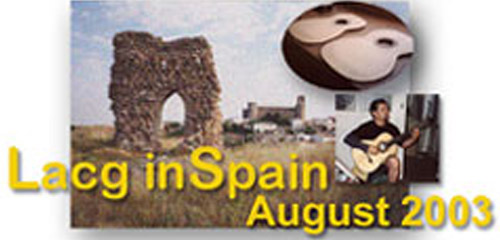As I sit down to write this, many memories come to mind and I reminisce about the great times and people that I had the privilege of meeting; having Miguel Rodriguez make my very first concert guitar and subsequently getting to know the Rodriguez family; having a few lessons with David Russell; my year at the Universidad Autonoma of Madrid; going to “El Revolver” every Wednesday night in the basement of a dilapidated building in Arguelles to see Ramón el Portugues, Cepero, and many other flamenco greats; the excitement of spending many hours at the Biblioteca Nacional looking over the original copies of Milán’s “El Maestro”, Narváez’s “Delphin de Música”, Fuenllana’s “Orphenica Lyra”, and many other fascinating books; the emotion of first seeing the Alhambra in Granada; the Roman aqueduct in Segovia… As a result, Spain has been a very important part of my life and directly influential in my formation as both a guitarist and a person. Regretfully, despite my eagerness to jot down all these experiences, I must limit my account of this beautiful country to my last visit there this past August.

My trip started in Barcelona, where I am fortunate to have family. To my pleasure, Barcelona has a very active guitar scene and in the evening of my arrival I went to see the Barcelona Guitar Ensemble at “Casa Luthier.” Among several interesting and beautiful works performed were the compositions of Eduardo Martín, a composer also featured in the Latin album by the LA Guitar Quartet, and a composition of Walfrido Domínguez, one of the members of the quartet.
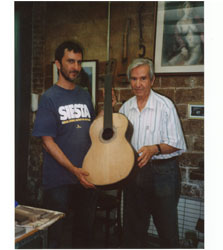
The following day I went to the studio of Rafael Cañizares, the brother of Juan Cañizares (a member of Paco de Lucia’s trio), for a flamenco guitar lesson. Rafael is an extraordinary flamenco player and as I left his studio I was immediately planning a return trip so that I could have more lessons with this great player. My next visit was to meet with Gabriel Fleta, where I was very kindly received, before heading for Madrid. This was my first time meeting the Fleta’s and I was delighted with their kindness and hospitality. Nonetheless, to my dismay, there was no chance of getting a Fleta since the waiting period extends decades!
Early the next morning I left for Madrid after picking up my rental car. In contrast to the day before, the streets were now empty of the hundreds of people, vendors and artists selling and performing around the old section of Barcelona. This made the drive out of the city less stressful and after thirty minutes I was on my way. I have never been good at remaining on the main highway since cialis suomi I easily become sidetracked on long sinuous roads. However, this time my departure from the main road took me to some fascinating places: Rodén, Belchite and Fuendetodos (birthplace of Francisco de Goya). As I was driving through the deserted countryside of Aragón, my heart stopped when suddenly around a turn I saw the hillside remains of the old city of Rodén. This town, after experiencing heavy bombardments and engaging in fierce house-to-house fighting, succumbed to the National Forces in 1937 during Spain’s Civil War. Subsequently, like the town of Belchite, Rodén was declared a national monument and is now abandoned and left to the decay of time.
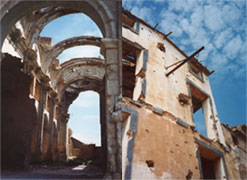
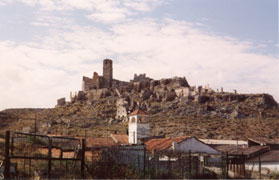
Bill Bailey, describing fighting in the town of Belchite in the book by David Mitchell, The Spanish Civil War (1982): “We would knock a hole through a wall with a pickaxe, throw in a few hand-grenades, make the hole bigger, climb through into the next house, and clear it from cellar to attic. And by God we did this, hour after hour. The dead were piled in the street, almost a storey high, and burnt. The engineers kept pouring on gasoline until the remains sank down. Then they came with big trucks and swept up the ashes. The whole town stank of burning flesh.” Now hopelessly behind schedule, I finally arrived at Madinter in Colmenar on the outskirts of Madrid. Miguel Malo has his workshop here and Vidal de Teresa and Miguel Ángel operate Madinter’s exports of high quality woods for musical instruments. In 1959, Miguel Malo became an apprentice at the Ramirez shop and worked there until 1993. Currently in our inventory is a Ramirez guitar stamped “AM” for Antonio Matinez Ortega, Miguel Malo’s uncle and the man responsible for introducing the young Malo to the Ramirez work shop.
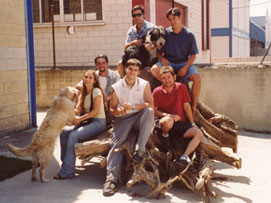
After settling in Madrid I spent the next week meeting with publishers and enjoying long evenings with old friends. One of my interesting days in Madrid was an excursion with Vidal De Teresa to Cuenca, where I met with Vicente Carrillo. I am indebted to Vidal for planning this outing and for enduring my daily presence during my stay in Madrid. Vicente’s shop is located in a tranquil little town hours from any big city commotion. Vicente’s guitars are very beautiful and I was grateful for spending time with him and having the opportunity to play some of his guitars. I also selected the spruce tops that will be on our next two Domingo Ortega guitars.


After a nice tour of the shop and tasting a wine drink prepared by Vicente, we were ready for lunch. The location for our lunch, Alarcón, was a true gift for my eyes and one of the most beautiful places that I have visited in Spain. The scenery was breathtaking and the sweltering heat, dry air, and the almost complete silence gave it the feeling of being deserted. This medieval town is perched upon a rugged hilltop protected by steep cliffs and surrounded by the river Júcar. Over the centuries it has changed hands from the Romans to the Moors until finally being conquered by the Christians in 1184. After lunch we thanked Vicente for his time and Vidal and I departed back to Madrid.
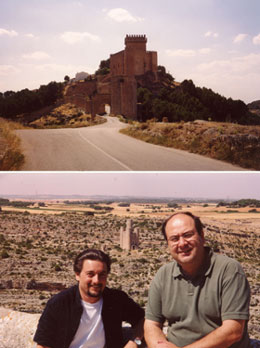
During my last few days in Madrid, I prepared for the trip south to Granada, the main reason I came to Spain. I had made this drive many times before and I knew there were a few places that I had not had the chance to see before. One of these places was Las Navas de Tolosa, where the Christians realized a decisive battle over the Moors in the year 1212. My curiosity was piqued after reading that the townspeople occasionally found coins, spearheads and other artifacts from this historic battle. This diversion took me far off the main road to what eventually became a dirt road that appeared to go nowhere. My stubbornness did not allow me to turn back.
Searching for antiquities turned out to be fruitless but I did arrive at the location where the cavalry encampment had been almost a thousand years ago. A plaque honoring this historic battle greeted me there in complete solitude.
Eventually I arrived in Granada. The heat was excruciating and I could see the Alhambra as beautiful as ever in the distance. I had waited four years for these guitars and they were finally ready.
It was a great pleasure to see Antonio Marín and José Marín Plazuelo again. I had last seen them two years ago when I entered the Julián Arcas competition in Almería. I have been playing a Marín guitar for six years and used it recently during a required recital for my master’s degree. I knew that both Antonio and José are making the best instruments of their careers and I was looking forward to seeing these new guitars. The guitars turned out to be as expected – the best I have seen to date. We talked, laughed and I played, but time was pressing and I was forced to bid farewell and begin my long drive back to Barcelona via Madrid, where I had to tie up a few loose ends.

Back in Barcelona I recuperated with family and friends before my return to the United States. Sadness was setting in as I packed, knowing that soon I would again have to face reality. My return flight had a two-day layover in Paris, a wonderful city that I had been wanting to revisit for some time. Since my aunt and cousin both live in Paris I planned on spending time with them, in addition to paying visits to various guitar makers. I went to the guitar shop of Dominique Fields and Henry Lemoine’s Editions, the sheet music publishing company. I attempted to meet the great Luthier Daniel Friederich, however, when I arrived at his shop it was closed and his neighbors informed me that they seldomly see Mr. Friederich at his shop anymore.

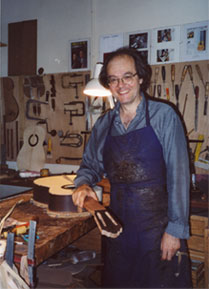
At Dominique Fields’ shop I was fortunate to find both Fields and Catherine Liolios. It is sometimes challenging to find shops open during the month of August because traditionally this is when most Europeans take their month long vacation. Catherine Liolios, a very fine player, performed for us and later allowed me to play the guitar that Fields had recently finished for her. It was my first time playing one of his guitars and I was surprised at how comfortable the neck felt and how easily I was able to produce a good tone. My experience is that I usually need a little time to familiarize myself with a new guitar and experiment with my right hand positioning in order to find a pleasing tone. In this case I felt immediately at ease with the instrument and was able to perform a few pieces for them. Fans of Dominique Fields will be disappointed to learn that his guitars currently have a twelve-year waiting period.
The next morning I said good-bye to my aunt and cousin and left for the airport, marking my very last moments on European soil. My flight home was uneventful and I arrived in Los Angeles feeling like I had left an old friend behind.
I hope that you found reading about my excursion to Spain enjoyable and informational. If you have any questions, corrections or comments, I’d like to hear them. Please e-mail me at sales@lacg.net
Thanks for reading and happy journeys!
LACG, Billy Arcila

